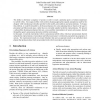Free Online Productivity Tools
i2Speak
i2Symbol
i2OCR
iTex2Img
iWeb2Print
iWeb2Shot
i2Type
iPdf2Split
iPdf2Merge
i2Bopomofo
i2Arabic
i2Style
i2Image
i2PDF
iLatex2Rtf
Sci2ools
AAMAS
2005
Springer
2005
Springer
Experiments in Subsymbolic Action Planning with Mobile Robots
The ability to determine a sequence of actions in order to reach a particular goal is of utmost importance to mobile robots. One major problem with symbolic planning approaches regards assumptions made by the designer while introducing externally specified world models, preconditions and postconditions. To bypass this problem, it would be desirable to develop mechanisms for action planning that are based on the agent’s perceptual and behavioural space, rather than on externally supplied symbolic representations. We present a subsymbolic planning mechanism that uses a non-symbolic representation of sensor-action space, learned through the agent’s autonomous interaction with the environment. In this paper, we present experiments with two autonomous mobile robots, which use autonomously learned subsymbolic representations of perceptual and behavioural space to determine goal-achieving sequences of actions. The experimental results we present illustrate that such an approach results ...
Related Content
| Added | 26 Jun 2010 |
| Updated | 26 Jun 2010 |
| Type | Conference |
| Year | 2005 |
| Where | AAMAS |
| Authors | John Pisokas, Ulrich Nehmzow |
Comments (0)

